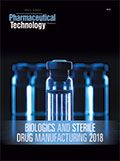Impact of Agitator Design on Bioreactor Performance
Aerobic bioprocesses are highly dependent upon the oxygen transfer rate (OTR) from sparged to dissolved gas. The relatively low solubility of oxygen, however, makes the choice of mixer impeller configuration a critical design factor for the bioreactor vessel. This article describes a series of experiments and computational fluid dynamics (CFD) simulations to detail the effect of mixer configuration on the efficiency and effectiveness of a bioreactor vessel with respect to blend time and mass transfer.

Aerobic bioprocesses are highly dependent upon the oxygen transfer rate (OTR) from sparged to dissolved gas. The relatively low solubility of oxygen, however, makes the choice of mixer impeller configuration a critical design factor for the bioreactor vessel. This article describes a series of experiments and computational fluid dynamics (CFD) simulations to detail the effect of mixer configuration on the efficiency and effectiveness of a bioreactor vessel with respect to blend time and mass transfer.
Read this article from Pharmaceutical Technology’s Biologics and Sterile Drug Manufacturing 2018 eBook.
Article Details
Pharmaceutical Technology
eBook: Biologics and Sterile Drug Manufacturing
Vol. 42
May 2018
Pages: 20–24
Citation
When referring to this article, please cite it as A. Strand and N. Courtemanche, "Impact of Agitator Design on Bioreactor Performance," Pharmaceutical Technology Biologics and Sterile Drug Manufacturing eBook (May 2018).
About the Authors
Aaron Strand, PE is a senior research engineer with SPX FLOW, aaron.strand@spxflow.com; Nicolle Courtemanche is a senior application engineer with SPX FLOW, nicolle.courtemanche@spxflow.com.

Drug Solutions Podcast: A Closer Look at mRNA in Oncology and Vaccines
April 30th 2024In this episode fo the Drug Solutions Podcast, etherna’s vice-president of Technology and Innovation, Stefaan De Koker, discusses the merits and challenges of using mRNA as the foundation for therapeutics in oncology as well as for vaccines.